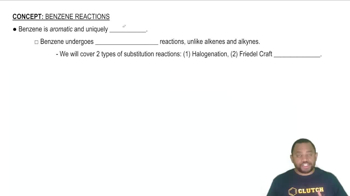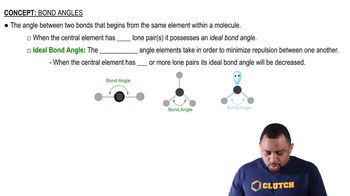Here are the essential concepts you must grasp in order to answer the question correctly.
Hybridization
Hybridization is the concept that describes the mixing of atomic orbitals to form new hybrid orbitals, which can explain the geometry of molecular structures. In benzene, each carbon atom undergoes sp² hybridization, resulting in three sp² hybrid orbitals that form sigma bonds with adjacent carbon atoms and hydrogen atoms, while the remaining unhybridized p orbital contributes to the delocalized pi bonding system.
Recommended video:
Planarity of Benzene
Benzene is a planar molecule due to the sp² hybridization of its carbon atoms, which allows for the formation of a flat, cyclic structure. The arrangement minimizes steric strain and maximizes overlap of p orbitals, leading to resonance stabilization. This planarity is crucial for the delocalization of electrons, which contributes to benzene's unique stability and reactivity.
Recommended video:
Bond Angles in Benzene
In benzene, the C-C-C bond angles are predicted to be approximately 120 degrees due to the trigonal planar arrangement of the sp² hybridized carbon atoms. This angle is characteristic of sp² hybridization, where the orbitals are arranged to minimize electron pair repulsion, resulting in a flat structure that supports the delocalization of pi electrons across the ring.
Recommended video:
 McMurry 8th Edition
McMurry 8th Edition Ch.8 - Covalent Compounds: Bonding Theories and Molecular Structure
Ch.8 - Covalent Compounds: Bonding Theories and Molecular Structure Problem 55
Problem 55
 Verified step by step guidance
Verified step by step guidance


